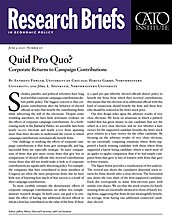One challenge to studying the effects of corporate campaign contributions is that firms give strategically, and big, successful firms are especially strategic. So naive comparisons of firms that give more versus firms that give less or comparisons of elected officials who received contributions versus those that did not would make it look as if corporate contributions are significantly distorting policy. For example, the companies that have contributed to more members of Congress are often the most prosperous firms, but we have little way of knowing how much of that success is a result of their campaign contributions.
To more credibly estimate the distortionary effects of corporate campaign contributions, we utilize two complementary research designs. In both cases, our goal is to estimate the effect of having one additional elected official to whom a firm has contributed on the value of the firm. If there is a quid pro quo whereby elected officials distort policy to benefit the firms from which they received contributions, this means that the election of an additional official with this kind of connection should benefit the firm, and these benefits should be realized in the firm’s stock price.
Our first design relies upon the arbitrary results of very close elections. We focus on situations in which a publicly traded firm has given money to one candidate (but not the other) in a very close election, and we test whether a bare victory for the supported candidate benefits the firm’s stock price relative to a bare victory for the other candidate. By focusing on the arbitrary results of very close elections, we are essentially comparing situations where firms supported a barely winning candidate with those where firms supported a barely losing candidate, which is much more of an apples-to-apples comparison than if we had simply compared firms that gave to lots of winners with firms that gave to fewer winners.
The figure below provides a visualization of this analysis. The vertical axis shows the cumulative abnormal stock returns for firms shortly after a close election. The horizontal axis shows the vote share of the firm-supported candidate. Each dot corresponds to many firm-election pairs with similar vote shares. We see that the stock returns for barely winning firms are essentially identical to those of barely losing firms, suggesting that firms do not meaningfully benefit, on average, from having one additional connected candidate elected.

